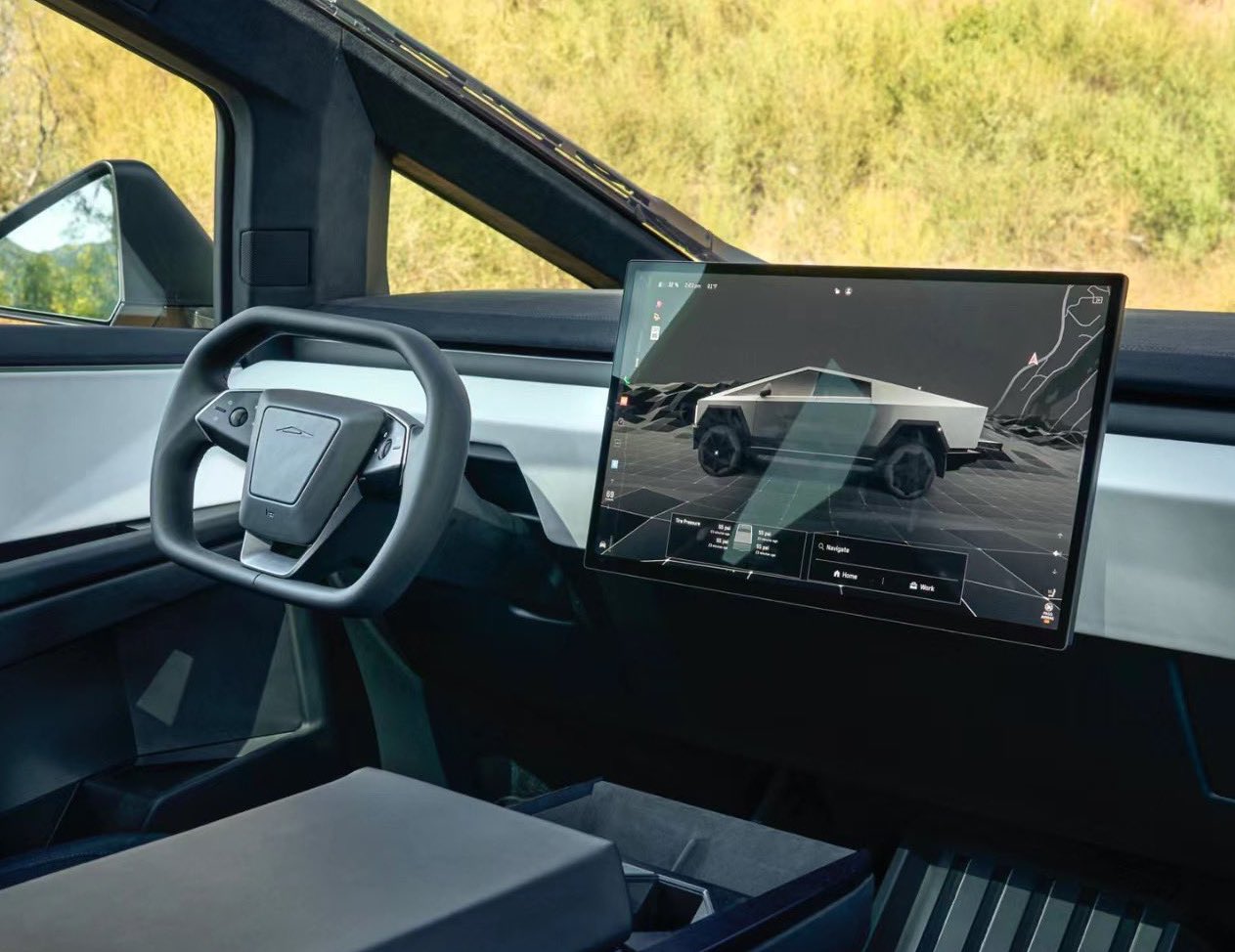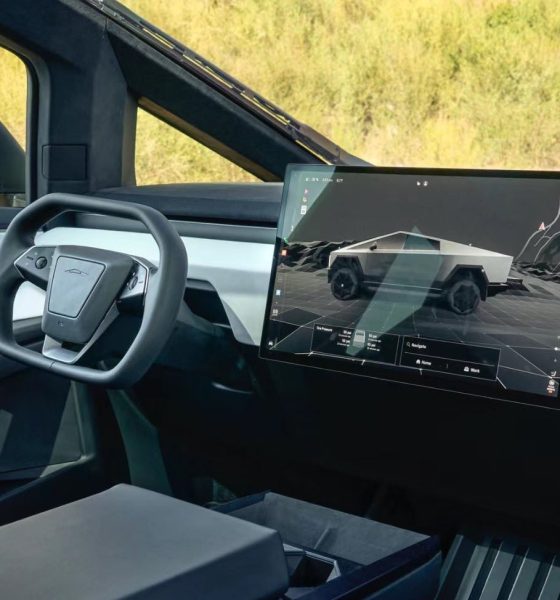Tesla began delivering initial Cybertruck units late last month, and many are curious about the details surrounding the highly anticipated electric vehicle (EV). In a recent interview, one automotive manufacturing expert sat down with five of Tesla’s top executives for a deep dive into the Cybertruck.
On Monday, lean manufacturing veteran Sandy Munro shared a video featuring a deep-dive interview about the Cybertruck with five of Tesla’s top executives. The executives include Tesla’s Head of Vehicle Engineering Lars Moravy, Head of Design Franz von Holzhausen, Head of Powertrain Drew Baglino, Head of Low-Voltage Hardware Pete Bannon, and Head of Software David Lau.
Interestingly, Munro notes at the beginning of the video that it was sponsored by Ford, which sells the F-150 Lightning, widely considered a competitor to the Cybertruck in the electric pickup space.
The nearly one-hour conversation covers a wide range of technical topics, notably including the unique EV’s revolutionary gigabit ethernet loop, or etherloop, which connects all of the Cybertruck’s high-speed controllers together. The result is a major reduction in wiring needed in the car, significantly reducing overall weight and communication latency.
As Bannon points out, the etherloop system reduces wiring needed in the vehicle from 490 wires across the Model 3 to just 155 in the Cybertruck, representing a roughly 68 percent decrease. This also comes despite the Cybertruck increasing end points to 368, from just 273 in the Model 3, highlighting the overall efficiency of the unique wiring system.
The executive also explains that the system improves communication speeds, increasing data flow with millisecond scale latency. Along with these improvements, the etherloop is also used to bi-directionally transmit audio data to the car’s speakers, both for using the sound system and for the Cybertruck’s active road noise cancellation system, which utilizes microphone and sensor data to decrease cabin noise.
Thank you to every single person who made our trip to Austin amazing@anuarbekiman @haya_austin @MattHolm3 @farzyness @woodhaus2 @baglino @eric_platzke @elonmusk and so many more pic.twitter.com/IzgrSbt5eg
— Sandy Munro (@teardowntitan) December 6, 2023
The conversation also touches on several other topics, including the Cybertruck’s stainless steel exoskeleton, Tesla’s Giga Press casting machines, the EV’s 4680 battery cells and much more. About halfway through the video, you can see Munro and the executives pivot from their seated conversation to a hands-on look at the Cybertruck’s various components
You can watch the full interview about the Cybertruck from Sandy Munro and five of Tesla’s executives below.
Updated 12:01 p.m. MT: Corrected number of wires in the Model 3 to 490 in the fifth paragraph. Edited the third paragraph for clarity.
What are your thoughts? Let me know at zach@teslarati.com, find me on X at @zacharyvisconti, or send your tips to us at tips@teslarati.com.

News
Tesla FSD fleet is nearing 7 billion total miles, including 2.5 billion city miles
As can be seen on Tesla’s official FSD webpage, vehicles equipped with the system have now navigated over 6.99 billion miles.

Tesla’s Full Self-Driving (Supervised) fleet is closing in on almost 7 billion total miles driven, as per data posted by the company on its official FSD webpage.
These figures hint at the massive scale of data fueling Tesla’s rapid FSD improvements, which have been quite notable as of late.
FSD mileage milestones
As can be seen on Tesla’s official FSD webpage, vehicles equipped with the system have now navigated over 6.99 billion miles. Tesla owner and avid FSD tester Whole Mars Catalog also shared a screenshot indicating that from the nearly 7 billion miles traveled by the FSD fleet, more than 2.5 billion miles were driven inside cities.
City miles are particularly valuable for complex urban scenarios like unprotected turns, pedestrian interactions, and traffic lights. This is also the difference-maker for FSD, as only complex solutions, such as Waymo’s self-driving taxis, operate similarly on inner-city streets. And even then, incidents such as the San Francisco blackouts have proven challenging for sensor-rich vehicles like Waymos.
Tesla’s data edge
Tesla has a number of advantages in the autonomous vehicle sector, one of which is the size of its fleet and the number of vehicles training FSD on real-world roads. Tesla’s nearly 7 billion FSD miles then allow the company to roll out updates that make its vehicles behave like they are being driven by experienced drivers, even if they are operating on their own.
So notable are Tesla’s improvements to FSD that NVIDIA Director of Robotics Jim Fan, after experiencing FSD v14, noted that the system is the first AI that passes what he described as a “Physical Turing Test.”
“Despite knowing exactly how robot learning works, I still find it magical watching the steering wheel turn by itself. First it feels surreal, next it becomes routine. Then, like the smartphone, taking it away actively hurts. This is how humanity gets rewired and glued to god-like technologies,” Fan wrote in a post on X.
News
Tesla starts showing how FSD will change lives in Europe
Local officials tested the system on narrow country roads and were impressed by FSD’s smooth, human-like driving, with some calling the service a game-changer for everyday life in areas that are far from urban centers.

Tesla has launched Europe’s first public shuttle service using Full Self-Driving (Supervised) in the rural Eifelkreis Bitburg-Prüm region of Germany, demonstrating how the technology can restore independence and mobility for people who struggle with limited transport options.
Local officials tested the system on narrow country roads and were impressed by FSD’s smooth, human-like driving, with some calling the service a game-changer for everyday life in areas that are far from urban centers.
Officials see real impact on rural residents
Arzfeld Mayor Johannes Kuhl and District Administrator Andreas Kruppert personally tested the Tesla shuttle service. This allowed them to see just how well FSD navigated winding lanes and rural roads confidently. Kruppert said, “Autonomous driving sounds like science fiction to many, but we simply see here that it works totally well in rural regions too.” Kuhl, for his part, also noted that FSD “feels like a very experienced driver.”
The pilot complements the area’s “Citizen Bus” program, which provides on-demand rides for elderly residents who can no longer drive themselves. Tesla Europe shared a video of a demonstration of the service, highlighting how FSD gives people their freedom back, even in places where public transport is not as prevalent.
What the Ministry for Economic Affairs and Transport says
Rhineland-Palatinate’s Minister Daniela Schmitt supported the project, praising the collaboration that made this “first of its kind in Europe” possible. As per the ministry, the rural rollout for the service shows FSD’s potential beyond major cities, and it delivers tangible benefits like grocery runs, doctor visits, and social connections for isolated residents.
“Reliable and flexible mobility is especially vital in rural areas. With the launch of a shuttle service using self-driving vehicles (FSD supervised) by Tesla in the Eifelkreis Bitburg-Prüm, an innovative pilot project is now getting underway that complements local community bus services. It is the first project of its kind in Europe.
“The result is a real gain for rural mobility: greater accessibility, more flexibility and tangible benefits for everyday life. A strong signal for innovation, cooperation and future-oriented mobility beyond urban centers,” the ministry wrote in a LinkedIn post.
News
Tesla China quietly posts Robotaxi-related job listing
Tesla China is currently seeking a Low Voltage Electrical Engineer to work on circuit board design for the company’s autonomous vehicles.

Tesla has posted a new job listing in Shanghai explicitly tied to its Robotaxi program, fueling speculation that the company is preparing to launch its dedicated autonomous ride-hailing service in China.
As noted in the listing, Tesla China is currently seeking a Low Voltage Electrical Engineer to work on circuit board design for the company’s autonomous vehicles.
Robotaxi-specific role
The listing, which was shared on social media platform X by industry watcher @tslaming, suggested that Tesla China is looking to fill the role urgently. The job listing itself specifically mentions that the person hired for the role will be working on the Low Voltage Hardware team, which would design the circuit boards that would serve as the nervous system of the Robotaxi.
Key tasks for the role, as indicated in the job listing, include collaboration with PCB layout, firmware, mechanical, program management, and validation teams, among other responsibilities. The role is based in Shanghai.
China Robotaxi launch
China represents a massive potential market for robotaxis, with its dense urban centers and supportive policies in select cities. Tesla has limited permission to roll out FSD in the country, though despite this, its vehicles have been hailed as among the best in the market when it comes to autonomous features. So far, at least, it appears that China supports Tesla’s FSD and Robotaxi rollout.
This was hinted at in November, when Tesla brought the Cybercab to the 8th China International Import Expo (CIIE) in Shanghai, marking the first time that the autonomous two-seater was brought to the Asia-Pacific region. The vehicle, despite not having a release date in China, received a significant amount of interest among the event’s attendees.










